Secure attachment fosters trust and emotional stability in relationships, while anxious attachment often leads to insecurity and fear of abandonment. Discover how these attachment styles impact your connections and strategies for healthier bonds in this article.
Table of Comparison
| Feature | Secure Attachment | Anxious Attachment |
|---|---|---|
| Emotional Regulation | Stable and controlled emotions | Intense, fluctuating emotions |
| Trust | High trust in relationships | Low trust, fear of abandonment |
| Dependence | Comfortable with intimacy and independence | Clingy, needs constant reassurance |
| Conflict Response | Calm, constructive problem-solving | Reactive, anxious, and preoccupied |
| Self-Esteem | Positive self-view | Low self-esteem, self-doubt |
| Relationship Stability | Consistent and secure bonds | Variable, often turbulent relationships |
Understanding Attachment Theory
Understanding attachment theory involves recognizing Secure Attachment as a healthy emotional connection where individuals feel safe and supported, promoting trust and effective communication. Anxious Attachment is characterized by insecurity and fear of abandonment, leading to clinginess and emotional volatility in relationships. Bonding refers to the initial deep emotional connection formed between individuals, especially between caregivers and infants, laying the foundation for future attachment styles.
What is Secure Attachment?
Secure attachment is a healthy emotional bond characterized by trust, comfort, and reliable support between individuals, often formed during early childhood with caregivers. It promotes resilience, positive self-esteem, and effective emotional regulation, enabling individuals to form stable and nurturing relationships in adulthood. Unlike anxious attachment, which involves fear of abandonment and insecurity, secure attachment provides a foundation for consistent emotional availability and mutual understanding.
What is Anxious Attachment?
Anxious attachment is characterized by a heightened fear of abandonment and excessive need for reassurance in relationships, often stemming from inconsistent caregiving in early childhood. This attachment style leads to emotional dependency and difficulty trusting others, causing challenges in forming secure and stable bonds. Understanding your anxious attachment patterns can help improve emotional regulation and foster healthier connections with others.
Key Differences: Secure vs Anxious Attachment
Secure attachment fosters trust, emotional safety, and healthy communication in relationships, while anxious attachment often triggers insecurity, clinginess, and fear of abandonment. Your ability to regulate emotions and form stable connections is strengthened by secure attachment, contrasting with the heightened anxiety and dependence seen in anxious attachment. Bonding refers to the initial emotional connection, which can influence whether secure or anxious attachment patterns develop over time.
Childhood Roots of Attachment Styles
Secure attachment develops in childhood when caregivers provide consistent emotional support, fostering trust and healthy relationship models. Anxious attachment emerges from inconsistent caregiving, leading to insecurity and heightened sensitivity to rejection. Bonding in early childhood forms the foundation for these attachment styles by shaping emotional regulation and interpersonal expectations.
Signs of a Secure Attachment in Relationships
Signs of a secure attachment in relationships include consistent emotional availability, trust, and effective communication between partners. Individuals with secure attachment exhibit comfort with intimacy, express their needs openly, and respond empathetically to their partner's emotions. This foundation promotes resilience, mutual support, and long-term relationship satisfaction, distinguishing it from anxious attachment patterns marked by fear of abandonment or inconsistent bonding experiences.
Signs of an Anxious Attachment in Relationships
Signs of an anxious attachment in relationships include constant worry about your partner's availability, fear of abandonment, and intense need for reassurance. You may experience emotional highs and lows, overanalyzing interactions and interpreting neutral actions as negative. This attachment style contrasts with secure attachment, where trust and comfort are present, and bonding, which involves forming a healthy emotional connection based on safety and mutual support.
Impact on Adult Romantic Relationships
Secure attachment fosters trust and emotional intimacy, enabling adults to maintain healthy, stable romantic relationships with effective communication and conflict resolution. Anxious attachment often leads to clinginess, fear of abandonment, and heightened sensitivity to partner behaviors, causing instability and emotional distress in relationships. Bonding in adulthood, shaped by early attachment patterns, reinforces emotional connection and mutual support, significantly influencing relationship satisfaction and resilience.
Strategies to Cultivate Secure Attachment
Cultivating secure attachment involves consistent responsiveness, emotional availability, and trusting communication between caregivers and individuals, fostering a foundation of safety and reliability. Strategies include practicing active listening, validating emotions, and establishing predictable routines to reduce anxiety and build trust. Encouraging open expression of needs and providing empathetic support strengthens bonding and counters patterns seen in anxious attachment.
Seeking Help: Therapy and Emotional Growth
Secure attachment fosters a confident approach to seeking help, encouraging open communication in therapy and promoting emotional growth through trust and vulnerability. Anxious attachment often triggers fears of rejection, making it challenging to ask for support, though therapy can gradually build self-worth and emotional regulation. Bonding, especially through therapeutic relationships, strengthens emotional resilience by providing a safe space for healing and deeper interpersonal connections.

Infographic: Secure Attachment vs Anxious Attachment
 relatioo.com
relatioo.com